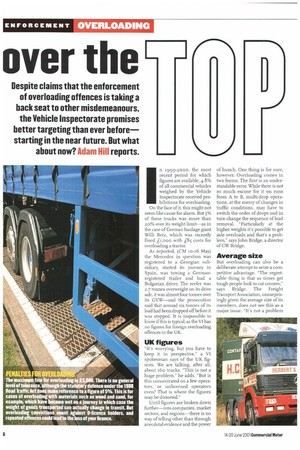over the L
Page 36

Page 37

If you've noticed an error in this article please click here to report it so we can fix it.
Despite claims that the enforcement of overloading offences is taking a back seat to other misdemeanours, the Vehicle Inspectorate promises better targeting than ever before— starting in the near future. But what about now? Adam Hill reports.
/I 1999-2000, the most recent period for which figures are available, 4.8% of all commercial vehicles weighed by the Vehicle Inspectorate received prohibitions for overloading.
On the face of it, this might not seem like cause for alarm. But 5% of these trucks was more than
zo% over its weight limit as in the case of German haulage giant Willi Betz, which was recently fined li,000 with g5 costs for overloading a tractor.
As reported, (CM ro-r6 May) the Mercedes in question was registered to a Georgian subsidiary, started its journey in Spain, was towing a Germanregistered trailer and had a Bulgarian driver. The reefer was 2.7 tonnes overweight on its drive axle, it was almost four tonnes over its GVW—and the prosecution said that around six tonnes of its load had been dropped offbefore it was stopped. It is impossible to know if this is typical, as the VI has no figures for foreign overloading offences in the UK.
UK figures
"It's worrying, but you have to keep it in perspective," a VI spokesman says of the UK figures. We are talking, after all, about r6o trucks. "This is not a huge problem," he adds. "But is this concentrated on a few operators, or unlicensed operators even? That is where the figures may be distorted."
Until figures are broken down further—into companies, market sectors, and regions—there is no way of telling other than through anecdotal evidence and the power
of hunch. One thing is for sure, however. Overloading comes in two forms. The first is an understandable error. While there is not so much excuse for it on runs from A to B, multi-drop operations, at the mercy of changes in traffic conditions, may have to switch the order of drops and in turn change the sequence of load removal. "Particularly at the higher weights it's possible to get axle overloads and that's a problem," says John Bridge, a director of CW Bridge.
Average size
But overloading can also be a deliberate attempt to seize a competitive advantage. "The regrettable thing is that as times get tough people look to cut corners," says Bridge. The Freight Transport Association, unsurprisingly given the average size of its members, does not see this as a major issue. "It's not a problem
we are finding our members suffering from much," a spokesman says. "But our impression is that the VI is spending less time on overloading and more on drivers' hours and tachograph offences."
Interestingly, however, one of the most common questions at the FTA's regional helpdesks is about axle tolerance. It believes that overloads should become less common due to factors such as hauliers becoming more pro
4 fessional about the
specification of their vehicles, and the prevalence of air suspension dis tributing loads more evenly.
But for hauliers of less predictable loads, such as refuse or aggregates, judging loads can be incredibly difficult. Refuse collection operators, for example, have no way of predicting what their vehicles will carry. And for hire-and-reward operators there will always be a temptation to sail close to the wind in maximising payload.
As Mark Herbert, transport manager of Maesteg, Bridgendbased HC Herbert (SE Sons, says: "The tipper boys get paid by the tonne which means the more weight they put on, the more money they get. Some will take chances. But 8o% of overloading is genuine mistakes."
Herberts is a removals company. "With furniture, with 1,400 cube on a van you can gross it out
at 11-12 tonnes; at someone else' house you can go up to r tonnes," he says. Something a mundane as large garden pot full of earth, for example, can b extraordinarily heavy.
Consignor liabilit,
One way to make deliberate ovei loading less attractive is to intrc duce consignor liability.
Since 1999 the Irish legal sr tern has added consignors to dr vers and owners as potentiz offenders. "Consignor liabilit has got to come," says Bridge. H reports that drivers he has know have occasionally voiced their six picions about loads which, whe. checked and weighed, bear littl relation to the records given ther by the consignors.
Quite apart from the illegalit such deception also negates th price-per-pallet that a haulier ha quoted for. And smaller haulier; perhaps, do not have the time c resources to check these claim;
Clearer targets
Bridge is well aware that th industry is not united on th consignor liability question, hr the former chairman of th Road Haulage Associatio remains hopeful: "We had t fight to get impounding. It's n( at the top of people's agenda: People take risks based on wlu they perceive are their chancE of being stopped—we need t increase enforcement."
And, despite the concerns ( those who say the VI is concei trating on tachograph and dr vers' hours offences at tit expense of overloading, the \ insists that things will get bett( due to its increasingly IT-base intelligence gathering operatio over the past couple of years.
"Over the next year or tw intelligence-based analyses wi give us individual operator records," says the VI spokesmai "We should be able to target be ter and look for the real rogues
































































































